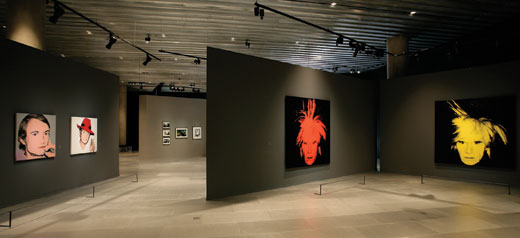 Summer 2007
Summer 2007“We expect that [the Korean audience’s] understanding of Korean contemporary artists will grow as they see Warhol’s art world.” - Hyesoo Woo, curator of the Korean exhibition |
 Andy Warhol Factory at the Leeum, Samsung Museum of Art in Seoul, South Korea.
The Traveling Factory
Twenty years after his death, Andy Warhol still gets around. Current stop: Seoul, Korea.A Campbell’s soup can. A brillo box. A silk-screened movie star. It’s hard to imagine such things as agents of change. But as Tom Sokolowski, director of The Andy Warhol Museum, has seen firsthand, a lot can be learned by the way a place reacts when Andy Warhol strolls into town—even 20 years after his death. “In places where they don’t get big shows of American artists in general,” says Sokolowski, “a Warhol exhibition becomes a sort of celebration of American, Western culture; everything hip and pop. Everything big and bright: American Idol, the new Lexus, cell phones. Warhol is the key that opened that lock to individual celebrity, selective dressing, everything that makes one step out of the crowd.” Not without some resistance, though. Take, for instance, the museum’s exhibition in Moscow in 2000. “Surprisingly, a couple of people took a very traditional Soviet position, asking, ‘Doesn’t Warhol represent the trouncing of the American proletariat by corporations?” notes Sokolowski. “Even then, that seemed so out of fashion. When the show opened, there were 10-year-old kids dressed as Uncle Sam playing Dixieland jazz.” Half a decade passed, when The Warhol returned to Russia for another exhibition, at the behest of the Alcoa Foundation, changes were apparent from the first moment: With a cadre of drag queens at the opening, “there was that feeling that you could put on a boa and get in a taxi without thinking you’d end up being locked up,” jokes Sokolowski. So when Andy Warhol Factory, a display of Warhol’s work commemorating the 20th anniversary of the pop icon’s death, opened just this past March at the Leeum, Samsung Museum of Art in Seoul, South Korea, it was hard to know what to expect. According to Hyesoo Woo, curator of the Korean exhibition, the reaction to Warhol in Seoul is not quite so visceral. After all, the Samsung already owns a number of Warhol silk screens, and there have been several shows of his work in Korea. But she believes this show’s importance runs deeper than the kinds of introductory overviews that have visited in the past. “Andy Warhol is already a well-known artist in Korea,” says Woo. “But Korean audiences just know Warhol’s style, not his basic ideas. And young Korean artists’ interest in Warhol’s art is much bigger—bigger than ever—as common life and consumptive life are becoming much more important themes of contemporary Korean art.” The Samsung Museum’s collaboration with The Andy Warhol Museum brings not just the usual suspects of Warholia to Korea—your soup cans, your Marilyns. Separated from the more famous works, Woo has collected a roomful of pieces that haven’t shown in the country previously: self-portraits, pieces from Warhol’s Death and Disaster series, early drawings, and photographs. It’s this kind of digging through the artist’s history that Sokolowski would like to encourage more of as the museum creates more traveling exhibitions. “We do both kinds of exhibitions: where our staff creates the exhibition and where we simply lend pieces, such as the current exhibition in Korea, where it’s only part curated by the museum,” says Sokolowski. But even when a curator arrives at The Warhol with a want-list of pieces for an exhibition, museum staff frequently suggests new ideas. “They may know the more well-known, published paintings and drawings, but not the stuff in our archives. So we can say, ‘if you want that piece, this lesser-known one would be great alongside it.’ “Sometimes when we do these shows it’s, ‘Can we have a Marilyn and a Campbell’s,” Sokolowski adds. “But when people are pointed in a different direction, they tend to see its value. One of the things about Warhol’s work: More than any other artist, if you’re not willing to put the work into it—unless you’re willing to dig a little bit—Warhol can seem like an easy read.” That mining is what the Samsung Museum was particularly interested in. According to Woo, while Korean artists know Warhol’s work fairly well and feel a growing relevance in pop art’s comments on commercialized culture, the greater community at large in Korea is less knowledgeable. “[Average] people don’t know Warhol very well,” notes Woo. “We thought that The Warhol’s retrospective would give Korean audiences a good opportunity to understand Warhol’s whole art world, and contemporary art in general. So we expect that their understanding of Korean contemporary artists will grow as they see Warhol’s art world |
Also in this issue:
Pittsburgh Glass · Time to Play · A New, More Personal Jesus · Mars Comes to Pittsburgh · Special Supplement: Thanks to Our Donors · Director's Note · NewsWorthy · Now Showing · Face Time: Anthony Rothbauer · About Town: Art Imitating Life · Field Trip: On the Road with Douglas Fogle · Science & Nature: Working the Bones · First Person: A Traveler's Diary · Another Look: Sol LeWitt Drawings
 |
Copyright © 2017 CARNEGIE Magazine. All rights reserved. |
